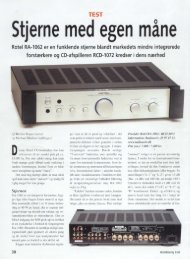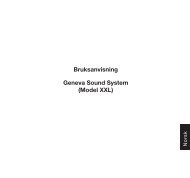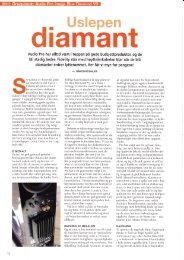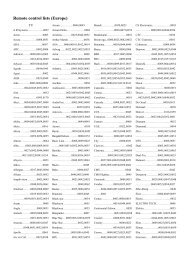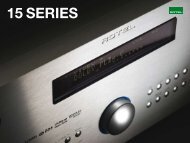Vincent SV-236 Hybrid Integrated Amplifier - Neby Hi-Fi Concept AS
Vincent SV-236 Hybrid Integrated Amplifier - Neby Hi-Fi Concept AS
Vincent SV-236 Hybrid Integrated Amplifier - Neby Hi-Fi Concept AS
You also want an ePaper? Increase the reach of your titles
YUMPU automatically turns print PDFs into web optimized ePapers that Google loves.
Barry Willis Equipment Review<br />
<strong>Vincent</strong> <strong>SV</strong>-<strong>236</strong> <strong>Hybrid</strong> <strong>Integrated</strong> <strong>Amplifier</strong><br />
Achtung! A Killer <strong>Integrated</strong> from Germany<br />
The <strong>Vincent</strong> <strong>SV</strong>-<strong>236</strong> arrived in a<br />
battered cardboard box with<br />
worn packaging that offered no<br />
clue as to what lay within—a gleaming<br />
brushed-aluminum integrated amplifier<br />
whose looks, features and performance<br />
belie its $1795 suggested retail price.<br />
One of several new <strong>Vincent</strong> models<br />
that debuted at the 2005 Consumer<br />
Electronics Show, the <strong>SV</strong>-<strong>236</strong> is a<br />
hybrid integrated dual-triode pre-amp<br />
mated to a solid state power amp, a<br />
design approach long proven to deliver<br />
the best of both worlds—the warm<br />
harmonic richness of tubes and the<br />
dynamic authority of solid state. Just<br />
say "no" to the heat and reliability<br />
problems of output tubes and the<br />
weight of output transformers.<br />
Externally, the <strong>Vincent</strong> is a beauty—elegantly<br />
designed and nicely<br />
crafted, silver throughout except for<br />
the black rear panel. Upfront are four<br />
large, easy-to-use knobs, three selfexplanatory<br />
function buttons (POWER,<br />
TONE, LOUD), and six input indicators.<br />
© Copyright 2005, Absolute Multimedia<br />
www.avguide.com<br />
The sides of the unit are thin-vaned<br />
heat sinks, all perfectly polished—no<br />
sharp edges anywhere, unlike many<br />
more expensive amps.<br />
In the center of the thick faceplate<br />
is an amber-lit round window, through<br />
Externally, the <strong>Vincent</strong> is<br />
a beauty—elegantly<br />
designed and nicely<br />
crafted, silver throughout<br />
except for the black rear<br />
panel.<br />
which is visible one of the tubes. The<br />
amber light can be dimmed or brightened<br />
in four steps via a DIMMER button<br />
on the slim metal remote control. The<br />
input select and volume are the only<br />
functions that are duplicated on the<br />
remote and on the front panel. The<br />
remote has a MUTE button that the<br />
front panel lacks; the LOUD and TONE<br />
controls can be engaged only via the<br />
front panel. A tiny red LED embedded<br />
in the amp's motorized volume control<br />
blinks when pressing volume up or<br />
down on the remote and when the<br />
amp is muted.<br />
The back panel on the <strong>SV</strong>-<strong>236</strong> has<br />
six pairs of gold-plated RCA input<br />
jacks (unbalanced), two pairs of linelevel<br />
outputs (rec out and pre out, but<br />
no tape monitor input and no power<br />
amp input), and four pairs of heavyduty<br />
gold-plated five-way binding<br />
posts—two pairs for each channel, for<br />
easy bi-wiring. There's no phono<br />
input—for that you need an external<br />
phono stage. In the lower center of the<br />
back panel is a receptacle for an<br />
industry standard 15A IEC power cord.<br />
The receptacle has an inboard AC fuse<br />
holder with a 10A fuse.<br />
The interior of the amp is equally<br />
well thought-out, with separate shielded<br />
compartments for power transformer<br />
(a "low noise" 5kV unit), pre-<br />
Page 24<br />
AVguide Monthly • JUNE 2005
Barry Willis Equipment Review<br />
amp, motorized volume control, and<br />
power output stages. The circuit layout<br />
is spare, with high-quality parts, including<br />
a pair of compact 63V/10,000uF<br />
power supply capacitors on each output<br />
board, matched sets of complimentary<br />
output transistors (flat-pack<br />
2SC 33519/ 2SA 1386), and poly caps<br />
in critical positions. The tone controls<br />
are passive, with all related components<br />
mounted on a separate board.<br />
Careful circuit layout and parts<br />
selection, combined with extensive<br />
internal shielding and what must be a<br />
superb grounding scheme, make the<br />
<strong>Vincent</strong> very quiet. Even with the volume<br />
control wide open, there was little<br />
residual noise. The manufacturer<br />
specifies signal:noise ratio at 90dB.<br />
Out-of-the-Box Performer<br />
The <strong>Vincent</strong> went into action right out<br />
of the box. I plugged it straight into the<br />
wall (no power conditioning) with the<br />
supplied AC cord and connected a 16'<br />
pair of Nordost SPM Reference bi-wire<br />
speaker cables to my Montana loudspeakers,<br />
a larger, custom-made version<br />
of the company's esteemed EPS<br />
model. My on-hand sources included a<br />
Marantz DVD-910 DVD player, an<br />
older California Audio Labs Icon CD<br />
player, and a modified Denon DVD-<br />
2900 universal player. I used <strong>Vincent</strong>'s<br />
supplied interconnect (maker<br />
unknown) as well as Kimber Silver<br />
Streak and a 2 meter pair of Nordost<br />
Quattro <strong>Fi</strong>l.<br />
What was immediately most apparent<br />
was the <strong>Vincent</strong>'s ability to produce<br />
deep, powerful, authoritative bass. No<br />
bigger than a budget-priced A/V<br />
receiver, the <strong>Vincent</strong> <strong>SV</strong>-<strong>236</strong> is a serious<br />
powerhouse. The seemingly bottomless<br />
bottom end had me plowing<br />
through my CD collection for bassheavy<br />
favorites—Patti Smith's superb<br />
cover of Prince's "When Doves Cry,"<br />
on Land, her two-disc retrospective<br />
[Arista Records], Kitty Margolis' jazzy<br />
treatment of "Money" on Left Coast<br />
Life [Mad-Kat Records], Pink's awesome<br />
hit "There You Go" from Can't<br />
Take Me Home [Laface/Arista], or<br />
Chuck Prophet's seductive "You Did"<br />
from his recent Age of Miracles [New West<br />
© Copyright 2005, Absolute Multimedia<br />
www.avguide.com<br />
Records]. The <strong>Vincent</strong>/SPM/Montana<br />
combo was a winner in the bass<br />
department—no subwoofer needed.<br />
But should you be so inclined, the<br />
<strong>Vincent</strong>'s "pre out" jacks are ideal for<br />
feeding an active subwoofer. So configured,<br />
my James 10 SG provided<br />
plenty of low-end reinforcement with<br />
the Montanas. It's important to have<br />
the right amount and the right quality<br />
of bass reinforcement—music without<br />
a strong foundation feels as insubstantial<br />
as a house built on stilts, as unsatisfying<br />
as a meal of cotton candy.<br />
The James sub was of more value<br />
in support of a pair of Silverline SR-11<br />
mini-monitors, by nature unable to render<br />
low bass unaided, but otherwise<br />
lovely performers. On 30" metal<br />
stands, and well out into the room, the<br />
Silverlines, driven by the <strong>Vincent</strong>,<br />
sang like Ferarri-red songbirds. Great<br />
amps should be capable not only of<br />
powerful, visceral bass, but of great<br />
delicacy, too. Bernadette Peters was<br />
right there in the room. "Cupid,"<br />
"Blackbird," and "<strong>Hi</strong>lls of<br />
Shiloh/Faithless Love" on her CD I'll<br />
Be Your Baby Tonight [EMI] were rendered<br />
with all the shimmering detail<br />
one would expect from excellent hi-fi<br />
gear—airiness and image stability in<br />
equal measure. Kathleen Battle's live<br />
performance of the Gershwin classic<br />
"Summertime" from Kathleen Battle at<br />
Carnegie Hall [Deutsche<br />
Grammophon] is perhaps the ultimate<br />
test of audio delicacy, one in which the<br />
<strong>Vincent</strong> scored a perfect 10.<br />
When it comes to hi-fi, I trust my<br />
own judgment—I've been messing<br />
about with audio for a very long time—<br />
but I also value the opinions of colleagues.<br />
Part of my agenda with the<br />
<strong>SV</strong>-<strong>236</strong> was to hear it with other speakers<br />
and auxiliary gear in another location.<br />
The Buddy Test<br />
I therefore leaned on my buddy Marc,<br />
a seasoned audiophile with an eclectic<br />
taste in music, to spend an evening<br />
with the <strong>Vincent</strong> driving some of his<br />
speakers. We had pounded the pavement<br />
in Las Vegas at CES this past<br />
January, but both of us had somehow<br />
missed the <strong>Vincent</strong> products. He's got<br />
a world-class home theater—Legacy<br />
Whispers powered by Halo JC-1<br />
amplifiers upfront and James S-103<br />
speakers in the rear, for example.<br />
For this audition we "turned around<br />
backwards," facing the opposite way<br />
we usually would for movies and<br />
music, and used the James as a<br />
stereo pair, pulled out into the room<br />
and fed from the <strong>Vincent</strong> via the same<br />
SPM Reference, but using the twochannel<br />
output from his Denon DVD-<br />
No bigger than a<br />
budget-priced A/V<br />
receiver, the <strong>Vincent</strong><br />
<strong>SV</strong>-<strong>236</strong> is a serious<br />
powerhouse.<br />
5900 as a source. We listened to some<br />
of the same material I had tried at<br />
home—Chuck Prophet was as<br />
prophetic over the James as he had<br />
been over the Montanas, with similar<br />
bowels-of-the-earth bass. We also listened<br />
to several two-channel<br />
SACDs—Aimee Mann, Patricia<br />
Barber, and Elton John. All of them<br />
proved worthy—the Mann for its<br />
densely orchestrated production, the<br />
Barber for its dark moodiness, and<br />
Elton John primarily for the placement<br />
of instruments in the soundstage. The<br />
<strong>SV</strong>-<strong>236</strong> never failed to deliver no matter<br />
what task we gave it.<br />
Marc mentioned that the <strong>Vincent</strong><br />
seemed capable of "almost surroundlike<br />
imaging" even though it's a basic<br />
two-channel amp. Like me, he was<br />
taken by its sheer effortless power and<br />
musicality. Not wishing to contaminate<br />
the experiment with any notion of<br />
value—there is way too much "label<br />
drinking" in hi-fi circles—I hadn't mentioned<br />
anything about the <strong>Vincent</strong>'s<br />
price.<br />
After an evening of listening, he<br />
called it an impressive piece of gear.<br />
Page 25<br />
AVguide Monthly • JUNE 2005
Barry Willis Equipment Review<br />
"How much? Four or five grand?" he<br />
asked. "Guess again," I replied. "Try<br />
eighteen hundred bucks." Silence,<br />
then, "That puts it in an entirely different<br />
light . . . Wow."<br />
The <strong>Vincent</strong> <strong>SV</strong>-<strong>236</strong> is very much<br />
state-of-the-art, but in some respects<br />
is also an old-school integrated. The<br />
tone controls, for example, let you easily<br />
correct for bass-shy speakers or<br />
overly-bright rooms or recordingstasks<br />
that audiophiles often approach<br />
though ornate experimentation with<br />
cables and room treatments and component<br />
synergy. The inclusion of tone<br />
controls will make some purists sniff,<br />
but so what? Somewhere along the<br />
way audiophiles got this bizarre, misguided<br />
notion that recordings were<br />
perfect and that including tone controls<br />
in amplifiers somehow besmirched<br />
© Copyright 2005, Absolute Multimedia<br />
www.avguide.com<br />
their perfection. It's beyond ridiculous.<br />
The object of the game shouldn't<br />
be about going broke in the pursuit of<br />
some abstract Holy Grail of <strong>Hi</strong>-fi. It<br />
should be about enjoying the widest<br />
variety of music with the greatest<br />
degree of enjoyment at the lowest possible<br />
cost. By that measure, the<br />
<strong>Vincent</strong> <strong>SV</strong>-<strong>236</strong> is a winner. If you're<br />
looking for long-term musical satisfaction,<br />
real-world versatility, and compatibility<br />
with almost every loudspeaker<br />
on the planet at a price that won't put<br />
you in debt for the next five years, the<br />
<strong>Vincent</strong> is for you.<br />
SPECIFICATIONS<br />
<strong>Vincent</strong> <strong>SV</strong>-<strong>236</strong> <strong>Hybrid</strong><br />
<strong>Integrated</strong> Vacuum Tube <strong>Amplifier</strong><br />
Power output: 100Wpc/8 ohms; 200<br />
Wpc/4 ohms<br />
Inputs: six analog (RCA)<br />
Outputs: two analog (1 Rec Out, 1 Pre<br />
Out, via RCA); two pairs,<br />
speaker tap (5-way binding posts)<br />
Dimensions: 17" x 5.5" x 17"<br />
Weight: 44 lbs.<br />
DISTRIBUTOR INFORMATION<br />
Q-USA<br />
462 N Baldwin St,<br />
Madison, WI 53703<br />
(608) 237-1726<br />
www.q-usa.com<br />
Price: $1795<br />
<strong>AS</strong>SOCIATED EQUIPMENT<br />
Marantz DVD-910, Denon DVD-2900,<br />
Denon DVD-5900, California Audio<br />
Labs Icon, Montana loudspeakers,<br />
Nordost SPM Reference bi-wire<br />
speaker cables<br />
Page 26<br />
AVguide Monthly • JUNE 2005




